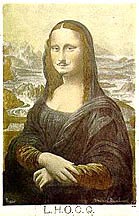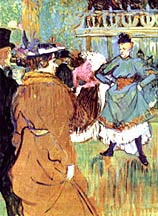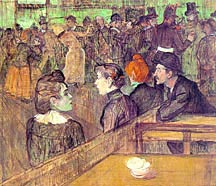

Post-Impressionism follows Impressionism. The artists involved were influenced by Impressionism although their work shares few similarities. Disinterested in recording light and color phenomena, Post-Impressionism is characterized by bright color, sharp, often outlined edges. In pursuit of individual goals, theories, and interests, they don't work or exhibit together.
![]()
Henri de Toulouse-Lautrec (too-LOOZ-loe-trek) 1864-1901
Fast Facts
Famous as an artist and as an aristocrat in Paris, Toulouse-Lautrec traveled and associated with the intellectuals of the era. Feeling physically grotesque, Lautrec removed himself from a traditional life in favor of the Parisian underworld from which his unromantic contemporary subjects were drawn. He painted social taboos and sordid truths of Parisian life in a straightforward unsentimental manner. The resulting work ironically elevates low life to high art. The general public found his work distasteful and shocking! He was influenced by Japanese prints and the Impressionist, Degas.

Quadrille at the Moulin Rouge, 1892
![]()

Moulin Rouge, 1893
![]()

The New Girls, 1893
![]()
Paul Cezanne (say ZAHN) 1839-1906
Fast Facts
Cezanne began painting outdoors in 1872 and exhibited with the Impressionists a few times before breaking with them in 1887. While the Impressionist's focused on dissolved form; Cezanne focused on arrangements of constructed forms. Young artists often romanticize the last twenty years of Cezanne's life spent in Provence in the South of France. Because they see him as a rebellious, reclusive primitive who “gave it all up to be an artist”, they take “artistic permission” from him. “If Cezanne did it, I can do it.”
Cezanne developed a theory of what art should be and then attempted to explain it through his paintings. He believed that there was hidden order in nature and that it was to be found in non-traditional, ambiguous space; therefore, he abandoned the traditional illusionist distinctions of foreground and background. His paintings are abstract, yet objects within them are recognizable. Cezanne's revolutionary theories and work lead to Cubism.
![]()
Still Life with Plate of Cherries, 1885
![]()
Compote, Pitcher and Fruit, 1892
![]()
![]()
Still Life with Flower Holder, 1905
![]()
![]()
![]()
![]()
![]()
![]()
Vincent van Gogh (GOE) 1853-1890
Fast Facts
Van Gogh turned to painting after disappointing attempts at other careers. Supported by his brother Theo, he went to Paris where he associated with and was influenced by the Impressionists. His avid moralizing and unceasing need for love, friendships and approval frightened people. He and his work were intense. It is questionable that he sold even one work.
![]()
Self-Portrait with Felt Hat, 1887
![]()
![]()
![]()
Van Gogh's Bedroom at Arles, 1889
![]()
![]()
Fourteen Sunflowers in a Vase, 1888
![]()
![]()
![]()
Wheat Field Under Threatening Skies, 1890
![]()
Paul Gauguin (go-GA(N)) 1848-1903
Fast Facts Paul Gauguin, a one-time stockbroker, left his middle class life, wife and family to establish a personal reality through art. At one point, he exhibited with the Impressionists then broke with them to work in artistic isolation. Gauguin believed that “painting should be a synthesis of remembered places rather than be the results of direct observation.” His paintings illustrate the world as he imagines it rather than as others see it.
Spirit of the Dead Watching, 1892
![]()
![]()
Van Gogh Painting Sunflowers, 1888
![]()
Auguste Rodin (roe-DAN) 1840-1917
Fast Facts
Prior to Rodin, academic sculpture lacked strong expression and sensitivity. Most often it was sentimental and idealized with an understood purpose to delight, inspire or educate. Rodin is the first modernist sculptor to break with that accepted tradition and make sculpture in which the experimental, creative process shows. Like Impressionist painters, Rodin was interested in the play of light on the surface of objects he observed in nature.
![]()
![]()
The Burghers of Calais - 1884-86
![]()
![]()
![]()
![]() Go back to the 20th Century Art
Categories
Go back to the 20th Century Art
Categories
![]() Go back to the 20th Century Art Welcome
Page
Go back to the 20th Century Art Welcome
Page
![]() Go Back to the West Valley College
Homepage
Go Back to the West Valley College
Homepage
